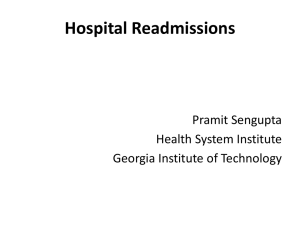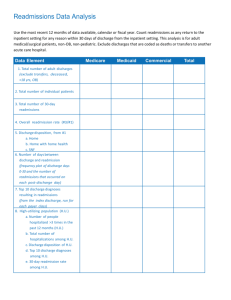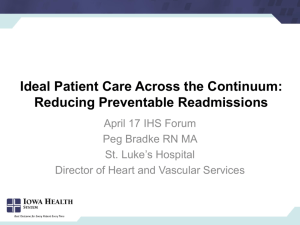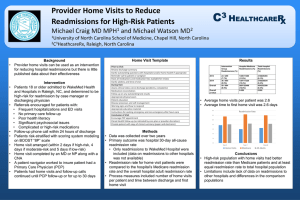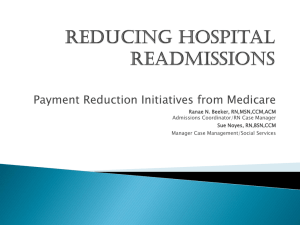impact
advertisement
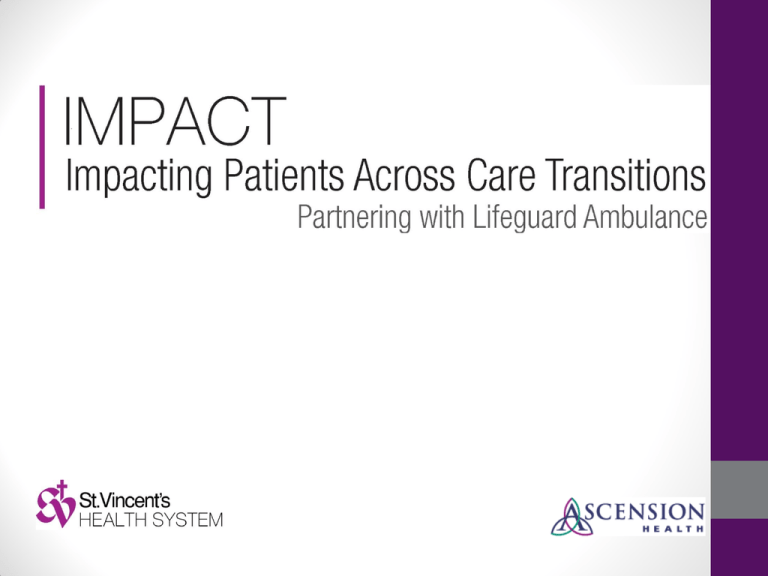
Background • Clinical Integration and Clinical Excellence Committee at the Ascension level developed the “Preventing Readmissions Bundle.” • Six Ascension Health Ministries serving as alpha sites committed to implementation of the readmissions bundle utilizing innovative and creative strategies. Goal The key goal for reducing readmissions for CHF, AMI, and Pneumonia is effective patient-centered interventions achieved by eliminating the silos across care transitions, appropriate use of available resources, and new models of care to manage patient populations most vulnerable for acute care readmissions. Program Development • Completion of Gap Analysis • Compare Preventing Readmissions Bundle with current processes to identify areas of improvement. • Review of Data • Review 12 months of readmission data to determine: • • • • Common causes for readmission Average day of readmission within 30 days Post-Acute setting the patient was discharged to Post-acute care setting for readmission (home health, skilled nursing facility, home etc.) • Multi-disciplinary team • Nurse Practitioners, nurses, pharmacists, case managers, chaplains, physicians, social workers, outcomes managers, information technology (IT), emergency medical technicians (EMTs). Preventing Readmissions Bundle • Improving the Discharge Planning Process and immediate Post-discharge Care Coordination Process • Eliminating Barriers to Primary Care Services for Patients • Implementing Transitional Care Services • Collaborating with SNFs, HH agencies and family members on optimizing care protocols • Utilizing Palliative Care Services Improving the Discharge Planning and immediate Postdischarge Care Coordination Process High Risk for Readmission Tool • Selected LACE • • • • Length of Stay Acute Admission versus Observation Co-Morbidities ED Visits in last six months • LACE tool completed as early in the admission as possible • Template built in EMR • Built alerts and daily reports for team members • Emails sent automatically at completion of LACE tool • Daily productivity report • Daily Discharge report Improving the Discharge Planning and immediate Post-discharge Care Coordination Process Continued • Education • Booklets created specific to diagnosis • Education provided by multiple disciplines • Medication Reconciliation throughout the care transitions • Built “Trigger” in Midas to assist in identification of most appropriate post-acute care setting • Implemented gap assessment tool into Midas to identify needs post-discharge • Assist with acquiring or providing resources to meet self-care needs in the home (education, scales, BP cuff, financial assistance) Eliminating Barriers to Primary Care Services for Patients • Schedule PCP appointments (48 to 72 hours) • Follow-up to determine if PCP appointment occurred • Communication hand-off to providers and post-acute care providers/facilities • Provide PCP patient information before scheduled appointment • Letter faxed to PCP when patient enrolls in IMPACT • Updates provided to PCP throughout 30 days after patient phone calls and patient visits Implementing Transitional Care Services • Care Transition Nurse (CTN) Hospital Visit • Educates patient while in the hospital • Enrolls in IMPACT • CTN Post-Discharge Visit within 48 to 72 hours of discharge • Educates patients and family members • Completes medication reconciliation • Develops 30 Day Care Plan • Physical Assessment • Determines frequency of calls and visits to be made by the care transition nurse, EMT, and Social Worker for the next 30 days • Provide “rescue” call number • Lifeguard Ambulance Service Collaborating with SNFs, HH agencies, and family members • Identification of preferred partners • Identification of post-acute care facilities with high readmissions • Developing mechanisms for better communication • AQAF Coalition Utilizing Palliative Care Services Program development underway. What really happens? Early Learnings and Challenges • Difficulty in identification of Patients with CHF, AMI, and Pneumonia • Challenge to schedule appointments with PCP within 48 to 72 hours post-discharge • Lack of alignment of post-acute care providers • Access to patient information across care transitions • No interface, lack of timely access to patient information by all providers of care • Lack of resources • Patient and family engagement Keys to Success • Measure, Measure, Measure • Continuous evaluation of data • Deep dives into readmissions by individual patients • Review of measures to determine what is working • Routine team meetings with team (weekly huddles and monthly results meetings) • Multi-disciplinary team approach • Inclusion of community partners • Willingness to change Gina Anderson, RN, BSN, MPPM System Vice President, Clinical Integration 50 Medical Park Drive East, Suite 220 Birmingham, Alabama 35235 P (205) 838-5770 / C (205) 965-6728 gina.anderson@stvhs.com
